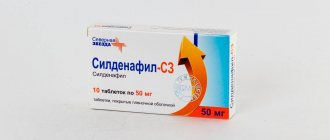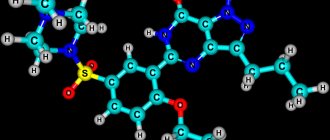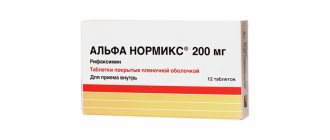Sealex Sildenafil, 1 piece, 50 mg, film-coated tablets
To diagnose erectile dysfunction, determine its possible causes and select adequate treatment, it is necessary to obtain a complete medical history and conduct a thorough physical examination. Erectile dysfunction treatments should be used with caution in patients with anatomical deformation of the penis (angulation, cavernous fibrosis, Peyronie's disease), or in patients with risk factors for priapism (sickle cell anemia, multiple myeloma, leukemia) (see section "Caution" ).
Medicines intended to treat erectile dysfunction should not be prescribed to men for whom sexual activity is undesirable.
If an erection persists for more than 4 hours, you should seek medical help. If priapism therapy is not carried out in a timely manner, this can lead to damage to the tissue of the penis and irreversible loss of potency.
Sexual activity poses a certain risk in the presence of heart disease, so before starting any therapy for erectile dysfunction, the doctor should refer the patient for an examination of the condition of the cardiovascular system. Sexual activity is undesirable in patients with heart failure, unstable angina, myocardial infarction or stroke in the last 6 months, life-threatening arrhythmias, arterial hypertension (BP >170/100 mm Hg) or hypotension (BP <90/50 mm Hg. Art.). Clinical studies have shown no difference in the incidence of myocardial infarction (1.1 per 100 people per year) or the incidence of cardiovascular mortality (0.3 per 100 people per year) in patients treated with sildenafil compared with patients treated with sildenafil. those receiving placebo.
Cardiovascular complications
During post-marketing use of sildenafil for the treatment of erectile dysfunction, adverse events such as serious cardiovascular events (including myocardial infarction, unstable angina, sudden cardiac death, ventricular arrhythmia, hemorrhagic stroke, transient ischemic attack, hypertension and hypotension) have been reported. ), which had a temporary association with the use of sildenafil. Most of these patients, but not all of them, had risk factors for cardiovascular complications. Many of these adverse events occurred shortly after sexual activity, and some of them occurred after taking sildenafil without subsequent sexual activity. It is not possible to establish a direct connection between the observed adverse events and these or other factors.
Hypotension
Sildenafil has a systemic vasodilating effect, leading to a transient decrease in blood pressure, which is not a clinically significant phenomenon and does not lead to any consequences in most patients. However, before prescribing sildenafil, the physician should carefully assess the risk of possible undesirable manifestations of the vasodilating effect in patients with relevant diseases, especially against the background of sexual activity. Increased susceptibility to vasodilators is observed in patients with obstruction of the left ventricular outflow tract (aortic stenosis, hypertrophic obstructive cardiomyopathy), as well as with the rare syndrome of multiple system atrophy, manifested by severe dysregulation of blood pressure from the autonomic nervous system. Since the combined use of sildenafil and α-blockers can lead to symptomatic hypotension in some sensitive patients, the drug should be prescribed with caution to patients taking α-blockers (see section "Interaction with other drugs"). To minimize the risk of postural hypotension in patients taking α-blockers, sildenafil should be started only after hemodynamic stability has been achieved in these patients. You should also consider the advisability of reducing the initial dose of sildenafil (see section "Dosage and Administration"). The physician should inform patients about what actions to take if symptoms of postural hypotension occur.
Visual impairment
Rare cases of anterior non-arteritic ischemic optic neuropathy as a cause of deterioration or loss of vision have been reported with the use of all PDE5 inhibitors, including sildenafil. Most of these patients had risk factors such as optic disc excavation, age over 50 years, diabetes mellitus, hypertension, coronary artery disease, hyperlipidemia, and smoking. A small number of patients with hereditary retinitis pigmentosa have genetically determined dysfunction of retinal phosphodiesterases. There is no information on the safety of sildenafil in patients with retinitis pigmentosa.
Hearing impairment
Some post-marketing and clinical studies have reported cases of sudden deterioration or loss of hearing associated with the use of all PDE5 inhibitors, including sildenafil. Most of these patients had risk factors for sudden deterioration or loss of hearing. A cause-and-effect relationship between the use of PDE5 inhibitors and sudden hearing loss or deterioration has not been established. If there is a sudden deterioration in hearing or hearing loss while taking sildenafil, you should consult your doctor immediately.
Bleeding
Sildenafil enhances the antiplatelet effect of sodium nitroprusside, a nitric oxide donor, on human platelets in vitro. There are no data on the safety of sildenafil in patients with a tendency to bleeding or exacerbation of gastric and duodenal ulcers, so sildenafil should be used with caution in these patients (see section "With caution"). The incidence of epistaxis in patients with PH associated with diffuse connective tissue diseases was higher (sildenafil 12.9%, placebo 0%) than in patients with primary pulmonary hypertension (sildenafil 3.0%, placebo 2.4%). Patients receiving sildenafil in combination with a vitamin K antagonist had a higher incidence of epistaxis (8.8%) than patients not taking a vitamin K antagonist (1.7%).
Use in conjunction with other means of treating erectile dysfunction
The safety and effectiveness of sildenafil in combination with other drugs for the treatment of erectile dysfunction have not been studied, therefore the use of such combinations is not recommended (see section "Contraindications").
Sealex®Sildenafil (Sealex Sildenafil)
To diagnose erectile dysfunction, determine its possible causes and select adequate treatment, it is necessary to obtain a complete medical history and conduct a thorough physical examination.
Erectile dysfunction treatments should be used with caution in patients with anatomical deformation of the penis (angulation, cavernous fibrosis, Peyronie's disease), or in patients with risk factors for priapism (sickle cell anemia, multiple myeloma, leukemia) (see section "Caution" ).
Medicines intended to treat erectile dysfunction should not be prescribed to men for whom sexual activity is undesirable.
If an erection persists for more than 4 hours, you should seek medical help. If priapism therapy is not carried out in a timely manner, this can lead to damage to the tissue of the penis and irreversible loss of potency.
Sexual activity poses a certain risk in the presence of heart disease, so before starting any therapy for erectile dysfunction, the doctor should refer the patient for an examination of the condition of the cardiovascular system.
Sexual activity is not advisable in patients with heart failure, unstable angina, myocardial infarction or stroke in the last 6 months, life-threatening arrhythmias, arterial hypertension (BP > 170/100 mm Hg) or hypotension (BP < 90/50 mm Hg. Art.). Clinical studies have shown no difference in the incidence of myocardial infarction (1.1 per 100 people per year) or the incidence of cardiovascular mortality (0.3 per 100 people per year) in patients treated with sildenafil compared with patients treated with sildenafil. those receiving placebo.
Cardiovascular complications
During post-marketing use of sildenafil for the treatment of erectile dysfunction, adverse events such as serious cardiovascular events (including myocardial infarction, unstable angina, sudden cardiac death, ventricular arrhythmia, hemorrhagic stroke, transient ischemic attack, hypertension and hypotension) have been reported. ), which had a temporary association with the use of sildenafil.
Most of these patients, but not all of them, had risk factors for cardiovascular complications. Many of these adverse events occurred shortly after sexual activity, and some of them occurred after taking sildenafil without subsequent sexual activity. It is not possible to establish a direct connection between the observed adverse events and these or other factors.
Hypotension
Sildenafil has a systemic vasodilating effect, leading to a transient decrease in blood pressure, which is not a clinically significant phenomenon and does not lead to any consequences in most patients. However, before prescribing sildenafil, the physician should carefully assess the risk of possible unwanted manifestations of the vasodilating effect in patients with relevant diseases, especially against the background of sexual activity.
Increased susceptibility to vasodilators is observed in patients with obstruction of the left ventricular outflow tract (aortic stenosis, hypertrophic obstructive cardiomyopathy), as well as with the rare syndrome of multiple system atrophy, manifested by severe dysregulation of blood pressure from the autonomic nervous system.
Since the combined use of sildenafil and α-blockers can lead to symptomatic hypotension in some sensitive patients, the drug should be prescribed with caution to patients taking α-blockers (see section "Interaction with other drugs"). To minimize the risk of postural hypotension in patients taking α-blockers, sildenafil should be started only after hemodynamic stability has been achieved in these patients. You should also consider the advisability of reducing the initial dose of sildenafil (see section "Dosage and Administration"). The physician should inform patients about what actions to take if symptoms of postural hypotension occur.
Visual impairment
Rare cases of anterior non-arteritic ischemic optic neuropathy as a cause of deterioration or loss of vision have been reported with the use of all PDE5 inhibitors, including sildenafil. Most of these patients had risk factors such as optic disc excavation, age over 50 years, diabetes mellitus, hypertension, coronary artery disease, hyperlipidemia, and smoking.
A small number of patients with hereditary retinitis pigmentosa have genetically determined dysfunction of retinal phosphodiesterases. There is no information on the safety of sildenafil in patients with retinitis pigmentosa.
Hearing impairment
Some post-marketing and clinical studies have reported cases of sudden deterioration or loss of hearing associated with the use of all PDE5 inhibitors, including sildenafil. Most of these patients had risk factors for sudden deterioration or loss of hearing. A cause-and-effect relationship between the use of PDE5 inhibitors and sudden hearing loss or deterioration has not been established. If there is a sudden deterioration in hearing or hearing loss while taking sildenafil, you should consult your doctor immediately.
Bleeding
Sildenafil enhances the antiplatelet effect of sodium nitroprusside, a nitric oxide donor, on human platelets in vitro.
There are no data on the safety of sildenafil in patients with a tendency to bleeding or exacerbation of gastric and duodenal ulcers, so sildenafil should be used with caution in these patients (see section "With caution").
The incidence of epistaxis in patients with PH associated with diffuse connective tissue diseases was higher (sildenafil 12.9%, placebo 0%) than in patients with primary pulmonary hypertension (sildenafil 3.0%, placebo 2.4%).
Patients receiving sildenafil in combination with a vitamin K antagonist had a higher incidence of epistaxis (8.8%) than patients not taking a vitamin K antagonist (1.7%).
Use in conjunction with other means of treating erectile dysfunction
The safety and effectiveness of sildenafil in combination with other drugs for the treatment of erectile dysfunction have not been studied, therefore the use of such combinations is not recommended (see section "Contraindications").
Sealex tab p/o captivity 100mg N 4
Active substance:
sildenafil
Dosage forms
Tab., cover. film-coated, 100 mg: 1, 2 or 4 pcs.
Tab., cover. film-coated, 50 mg: 1, 2 or 4 pcs.
Release form, packaging and composition of the drug Sealex® Sildenafil
Pink, biconvex, diamond-shaped film-coated tablets with cut and rounded edges, engraved “50” on one side; On a cross section, the core of the tablet is white or almost white.
| 1 tab. | |
| sildenafil citrate | 70.2 mg, |
| which corresponds to the content of sildenafil | 50 mg |
Excipients: corn starch - 156.0 mg, microcrystalline cellulose - 74.0 mg, magnesium stearate - 5.0 mg, talc - 5.0 mg, colloidal silicon dioxide - 3.0 mg, sodium carboxymethyl starch - 10.0 mg. Instacoat pink film coating - 12.0 mg: titanium dioxide - 1.1 mg, red iron oxide dye - 1.6 mg, hypromellose - 3.2 mg, macrogol - 3.7 mg, talc - 0.4 mg.
1 PC. - blisters (1) - cardboard packs. 2 pcs. - blisters (1) - cardboard packs. 4 things. - blisters (1) - cardboard packs.
Blue film-coated tablets, biconvex, diamond-shaped with cut and rounded edges, engraved “100” on one side; On a cross section, the core of the tablet is white or almost white.
| 1 tab. | |
| sildenafil citrate | 140.5 mg, |
| which corresponds to the content of sildenafil | 100 mg |
Excipients: corn starch - 223.0 mg, microcrystalline cellulose - 110.0 mg, magnesium stearate - 8.0 mg, talc - 5.0 mg, colloidal silicon dioxide - 3.0 mg, sodium carboxymethyl starch - 10.0 mg. Instacoat film coating blue - 12.0 mg: titanium dioxide - 1.3 mg, brilliant blue dye - 1.9 mg, hypromellose - 3.8 mg, macrogol - 4.5 mg, talc - 0.5 mg.
1 PC. - blisters (1) - cardboard packs. 2 pcs. - blisters (1) - cardboard packs. 4 things. - blisters (1) - cardboard packs.
Clinical and pharmacological group:
A drug for the treatment of erectile dysfunction. PDE5 inhibitor
Pharmacotherapeutic group:
Erectile dysfunction treatment, PDE5 inhibitor
pharmachologic effect
Selective inhibitor of cycloguanosine monophosphate (cGMP)-specific PDE5. PDE5, responsible for the breakdown of cGMP, is found not only in the corpus cavernosum of the penis, but also in the vessels of the lungs.
Restores impaired erectile function and provides a natural response to sexual arousal. Sildenafil does not have a direct relaxing effect on the corpus cavernosum, but actively enhances the relaxing effect of nitric oxide on this tissue. During sexual arousal, local release of NO under the influence of sildenafil leads to inhibition of PDE5 and an increase in the level of cGMP in the corpus cavernosum, resulting in relaxation of smooth muscles and increased blood flow in the corpus cavernosum.
As a PDE5 inhibitor, sildenafil increases the content of cGMP in the smooth muscle cells of the pulmonary vessels and causes them to relax. In patients with pulmonary hypertension, taking sildenafil leads to dilation of the pulmonary vessels and, to a lesser extent, other vessels.
Sildenafil is selective for PDE5 in vitro. Its activity against PDE5 is 10 times greater than that against other known PDE isoenzymes: PDE6, which is involved in transmitting the light signal in the retina of the eye; PDE1 - 80 times; PDE2, PDE4, PDE7-PDE11 - more than 700 times. The activity of sildenafil against PDE5 is more than 4000 times greater than its activity against PDE3, a cAMP-specific PDE involved in heart contraction.
Sildenafil may cause mild and transient impairment of color discrimination (blue/green). The putative mechanism for color vision impairment is the inhibition of PDE6, which is involved in the process of light transmission in the retina. In vitro studies have shown that the effect of sildenafil on PDE6 is 10 times lower than its activity on PDE5.
Indications of the active substances of the drug Sealex® Sildenafil
Treatment of erectile dysfunction, characterized by the inability to achieve or maintain a penile erection sufficient for satisfactory sexual intercourse.
Pulmonary hypertension.
Dosage regimen
The method of administration and dosage regimen of a particular drug depend on its release form and other factors. The optimal dosage regimen is determined by the doctor. The compliance of the dosage form of a particular drug with the indications for use and dosage regimen should be strictly observed.
Treatment of erectile dysfunction: taken orally approximately 1 hour before planned sexual activity. A single dose is 50 mg. Taking into account effectiveness and tolerability, the dose can be increased to 100 mg or reduced to 25 mg. The maximum single dose is 100 mg. The maximum frequency of use is 1 time/day. For elderly patients over the age of 65 years and with concomitant renal or hepatic impairment, the dose is 25 mg.
Pulmonary hypertension: orally 20 mg 3 times a day with an interval of about 6-8 hours, regardless of meals. The maximum daily dose is 60 mg. In patients with impaired renal function, no dose adjustment is required, however, if tolerated poorly, the dose is reduced to 20 mg 2 times a day.


